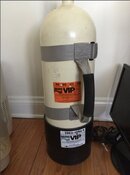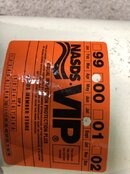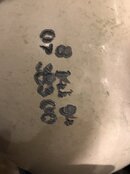lets hope it's full of air not oxygen as that would be toxic at depth. depending on how long it's been sitting, I'm not sure I'd want to breathe it either. About the only good thing about something in the tank is that it keeps other stuff out.
Judging from the NASDS VIP's it looks like a vintage 90's aluminum tank. Some around that time period (or possibly a little earlier) were condemned due to stress fractures in the neck.
You can figure out if it's one here -
Is my cylinder made from the "bad" alloy aka AL6351?
If it's a steel, all it would need it to be tumbled to remove any rust. I don't believe it's a steel though.
This is totally a
guess but I think it's an AL-80 - popular around that time and they came in white.
Most steel tanks are steel colored.
B4 you pay good money see if the seller is willing to have it inspected. He may not as that's not cheap relative to the value of an old used tank he's trying to sell.
Most shops have a paid inspection where they remove the valve and stick a light in to check for problems. Plan on having the valve serviced on your dime also.
what's the price?


 I had the opportunity to get a scuba tank from a person who is getting out of diving the tank is in pristine condition and is full of oxygen as well. I wasn’t able to ask the individual more questions about it and since I’m new at this and am still learning Im hopeful someone can give me more information about it.
I had the opportunity to get a scuba tank from a person who is getting out of diving the tank is in pristine condition and is full of oxygen as well. I wasn’t able to ask the individual more questions about it and since I’m new at this and am still learning Im hopeful someone can give me more information about it. 


